Happy Candlemas – St Brigid’s Celebration
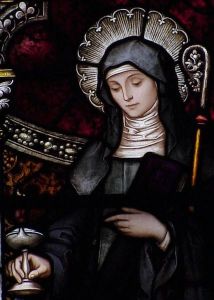
Happy Candlemas!
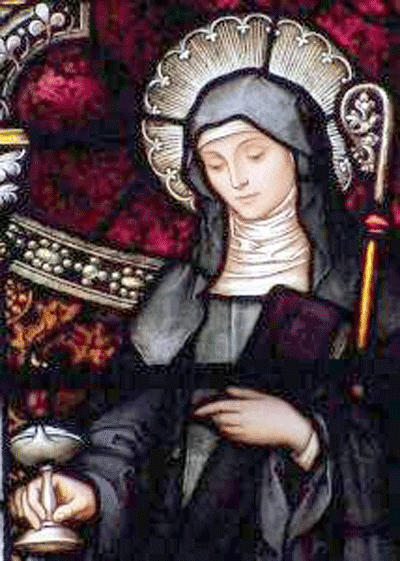
St. Brigid stained glass window
February 2nd – 02/02 – The feast of the flames – the bringing of the light.
This is also the Christian feast of the Presentation of the Lord Jesus in the Temple – the 40th day of the Christmas season.
So many cultures mark this day as a day to think of spring, of the thawing of the earth, the ending of the darkness, the long nights, the coming of the light. We think of St. Brigid of Kildare – Brigid the saint who brought the light of the Word, bread for the poor, peace to the troubled and welcome to the stranger whose feast day – February 1st is part of the “light” celebration.
Tree of the Day series
This is also the day I start a “Tree of the Day series” where I will post images of trees in thin places I have visit. These are special trees – fairy trees, healing trees, trees of mystery, trees associated with stories.
The Tobar Bhride Tree – Kildare
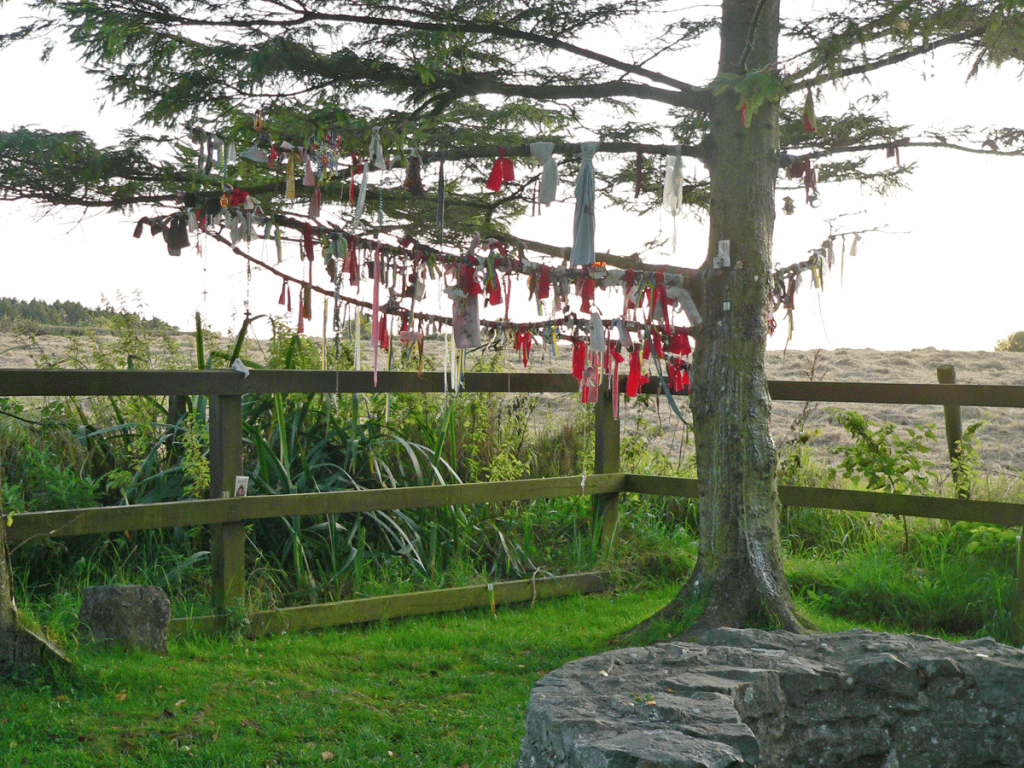
The tree at Tobar Bhride – Kildare
Today I’ll give you the tree at Tobar Bhride (Brigid’s Well) in Kildare. Local people and pilgrims from all over the world visit this well and the tree beside it bringing their prayers of devotion, special intentions and hearts full of thanksgiving for prayers answered.
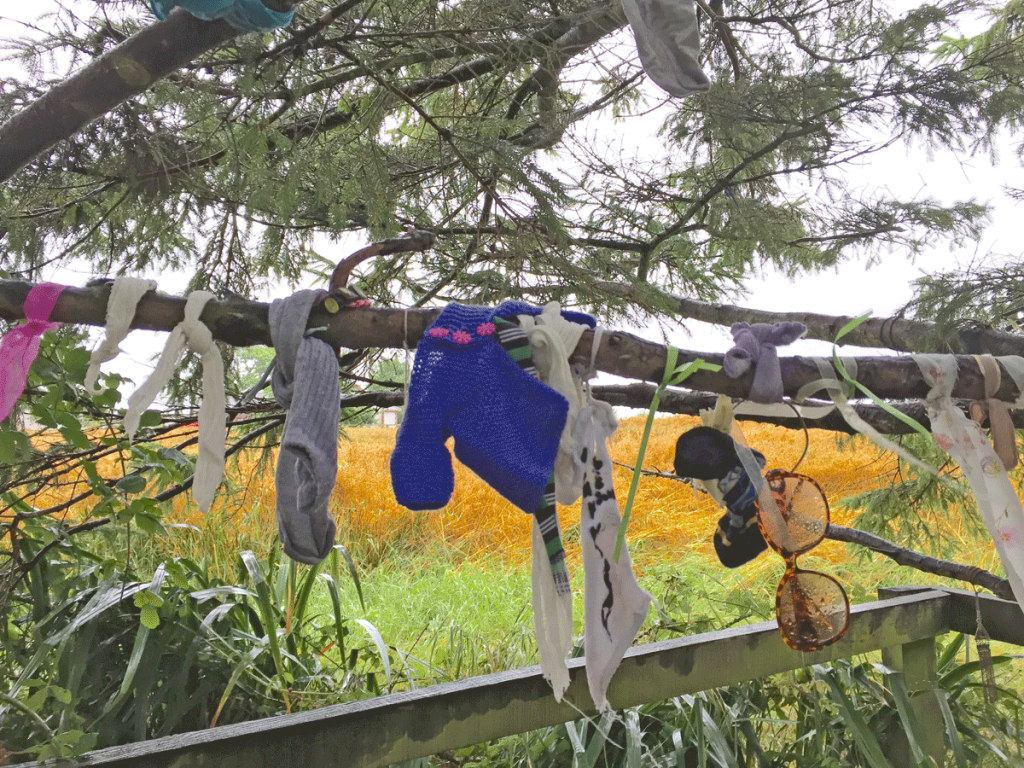
Tokens – “clooties” left on the branches.
As a sign of devotion, the faithful who visit the well sometimes leave a physical reminder of their prayer behind by tying a rag to the tree beside the well. Sometimes they leave something else of meaning behind – a possession of the person for whom they are praying, a photo, a prayer card. These tokens are called “clooties” and the lower branches of the Tobar Bhride tree is covered with them. Some of the clooties pull at the heart of the observer. .. pictures of sick mother, baby shoes, hair ties, little toys.
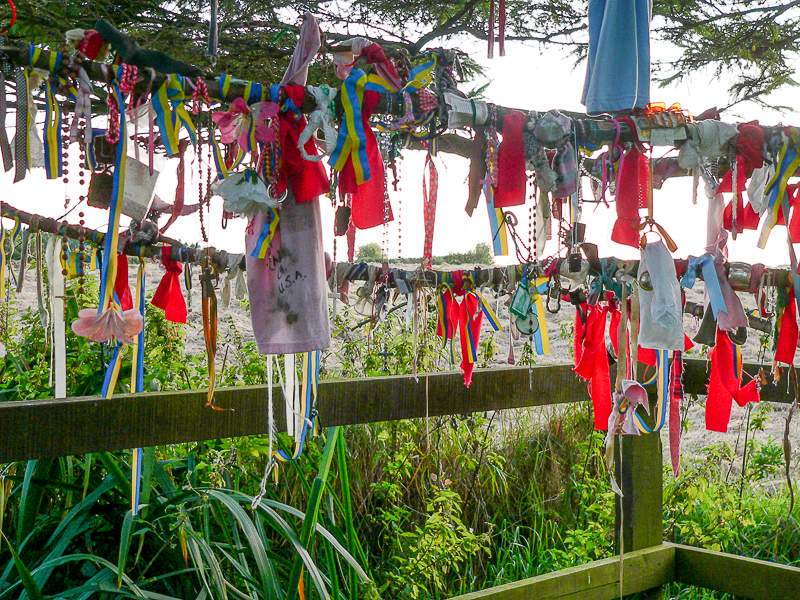
Clooties at Tobar Bhride Kildare
The local people who care for the well and its garden remove the clooties regularly to make way for more. According to the locals, the clooties are buried nearby. One cannot stand by the Tobar Bhride tree and not be moved. It has a quiet but powerful energy.
This tree, the holy well and the Solas Bhride center are a stop on the Discover the North, Castles & Saints and Trail of the Hag tours.
St. Gobnait – Patron of Beekeepers – County Cork
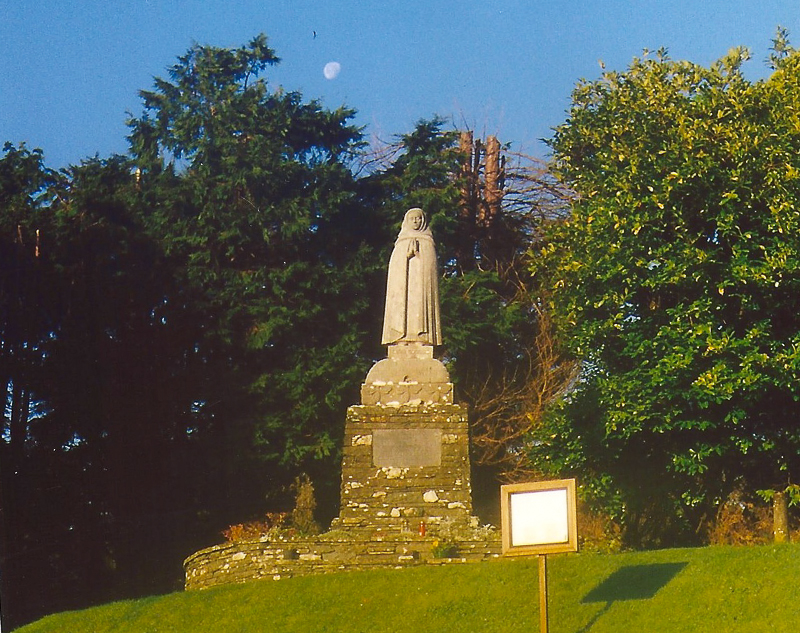
The Beekeepers’ Saint – Gobnait of Beekeepers
St. Gobnait (Irish for Deborah or Abigail), the patroness of Beekeepers and healers, is celebrated in Ballyvourney, a small town in West Cork. Her Feast Day is February 11th.

St. Gobnait, patron of beekeepers – Image by Patricia Banker
In the early 6th century when Gobnait fled her home in County Clare, she went to Inis Oírr (the smallest of the Aran Islands). We don’t know why she fled, only that she believed she would find refuge in the Aran Islands. Legend states that an angel appeared to her there and told her that her place was not on Inis Oírr, and instructed Gobnait to go on a journey – to seek her true place of resurrection. “Go until you find nine white deer grazing, ” the angel told her. “It is there that you will find your place of resurrection.” So Gobnait wandered about the southern coastal counties of Ireland – Waterford, Cor, and Kerry – searching.
She saw three white deer in Clondrohid and followed them to Ballymakeera where she saw six more. But it wasn’t until she came to Ballyvourney to a small rise overlooking the River Sullane that she saw the nine white deer all together – grazing … just as the angel from Inis Oírr had prophesied. She crossed the river and settled there. She founded a religious community for women, performed memorable – some say miraculous – works, and it was there she died and was buried.
St. Gobnait’s journey from Inis Oirr to the towns in West Cork including sites in Ballyvourney – her monastic settlement, tomb, and holy well are part of the Places of Resurrection tour.
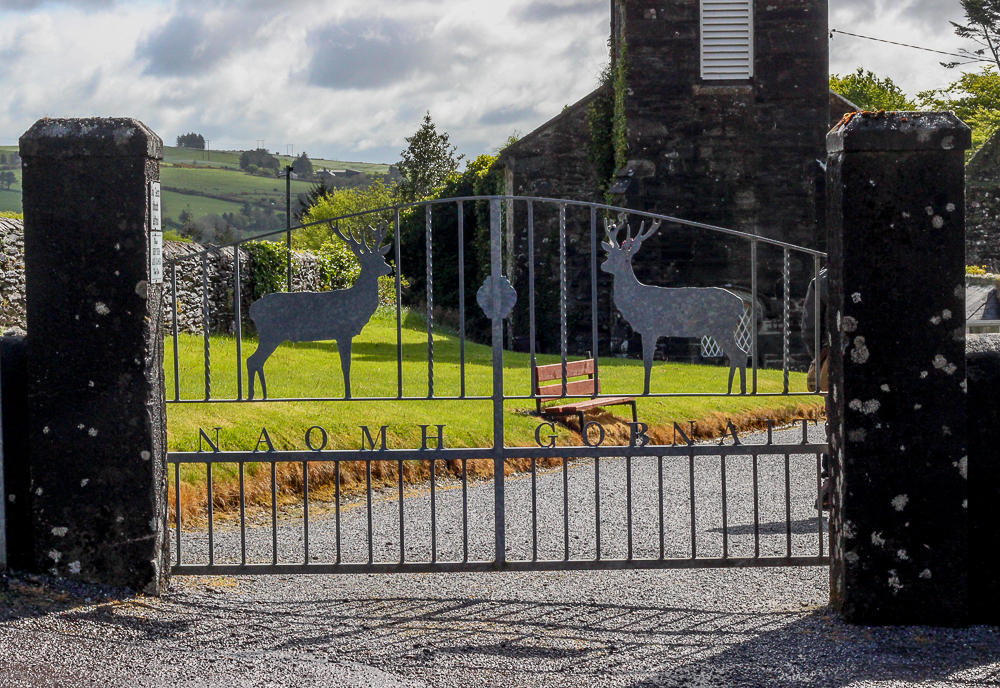
On February 11th (St. Gobnait’s feast day) she is tenderly remembered in her native region. But she has also been proclaimed by the Irish bishops to be a national saint. There are shrines and places of devotion to St. Gobnait in all the places she is believed to have stopped on her journey – including Inis Oírr. But Ballyvourney – is that special place for Gobnait… the place she felt most at home, the place where she carried out most of her ministry. And Ballyvourney is the place that draws the greatest number of pilgrims devoted to this saint.
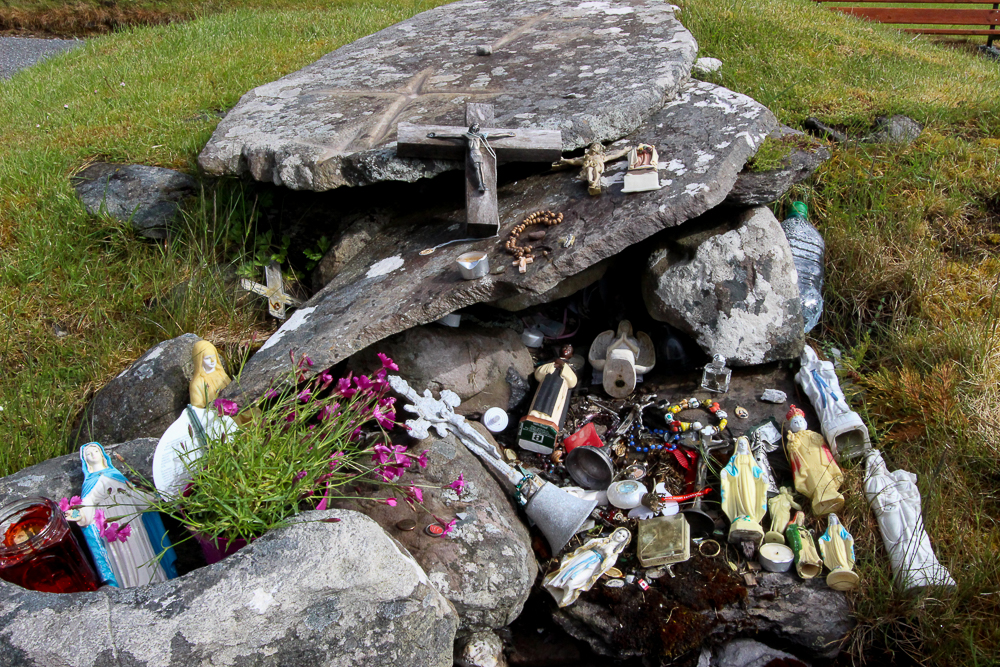
St. Gobnait’s Tomb Ballyvourney – County Cork
Today there is an active church on the former monastic site. St. Gobnait’s grave and marked spots around the churchyard are places where pilgrims pause for devotion and reflection. It is here that they can do the “rounds” or turas, always moving in a clockwise direction – a tradition that has pagan roots. One of the strongest mystical draws on this site is St. Gobnait’s Holy Well, with its arched entryway that takes the pilgrim into a deeply shaded path. Just next to the well is a sturdy tree, and hanging from it are hundreds of tokens or “clooties ” that have been placed there by pilgrims hoping to leave behind a part of themselves or loved on in need of healing. There are taps and cups available for drinking from the well or for pouring into personal vessels to take holy well water home.
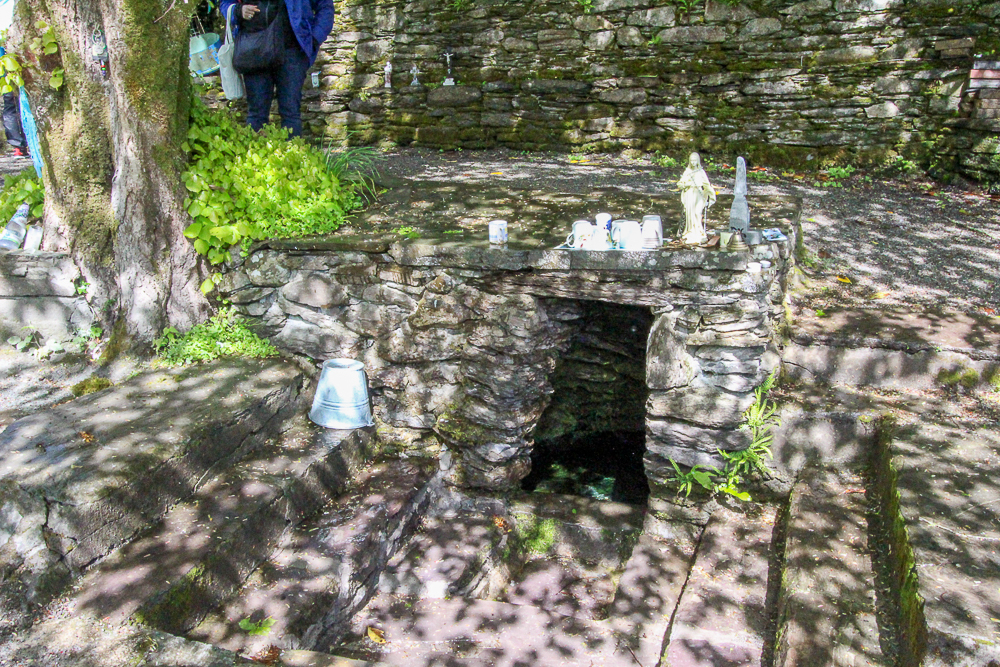
St. Gobnait’s Holy Well – Ballyvourney, Co. Cork
St. Gobnait was best known for her care of the sick. There is a legend that tells of her staving off the plague from Ballyvourney by drawing a line in sand with a stick and declaring the village “consecrated ground.” Inside the church today, there is a medieval (possibly 13th century) figure of St. Gobnait which is kept in a drawer. Every year on her feast day, the parish priest brings out the figure to celebrate a devotional tradition. He holds up the ancient figure and the faithful each step forward with a piece of ribbon. They hold the ribbon up and measure it against the length and around the circumference of the figure, then take it home as a blessed relic used for healing or further devotion.
A tall statue of St. Gobnait that was erected in the 1950s stands near the monastic site. She appears with a nun’s habit standing on a beehive surrounded by bees. Gobnait is the patron saint of beekeepers, and there are several legends recalling Gobnait forcing invaders out of Ballyvourney by setting swarms of bees upon them. It’s probable that Gobnait had a close relationship with bees and used honey in healing efforts.
PLACE OF RESURRECTION
Dan and I visited St. Gobnait’s monastic site many years ago. It is indeed, a thin place. The stories of St. Gobnait specifically mention a “place of resurrection.” I heard Dara Molloy use this phrase when referring to his home on Inis Mór and have seen a few authors reference the phrase. But regarding thin places … a place of resurrection is the pinnacle – that place where one’s spirit is totally whole, at home, with no longing or yearning to be anywhere else. A place of resurrection is not only the place where one’s spirit will resurrect from its lifeless body upon death, but also the place where that spirit is most alive inside the living body. And I believe that a place of resurrection is the spiritual home where one is most completely alive and able to create, to discern, to prophesy … to be wise.
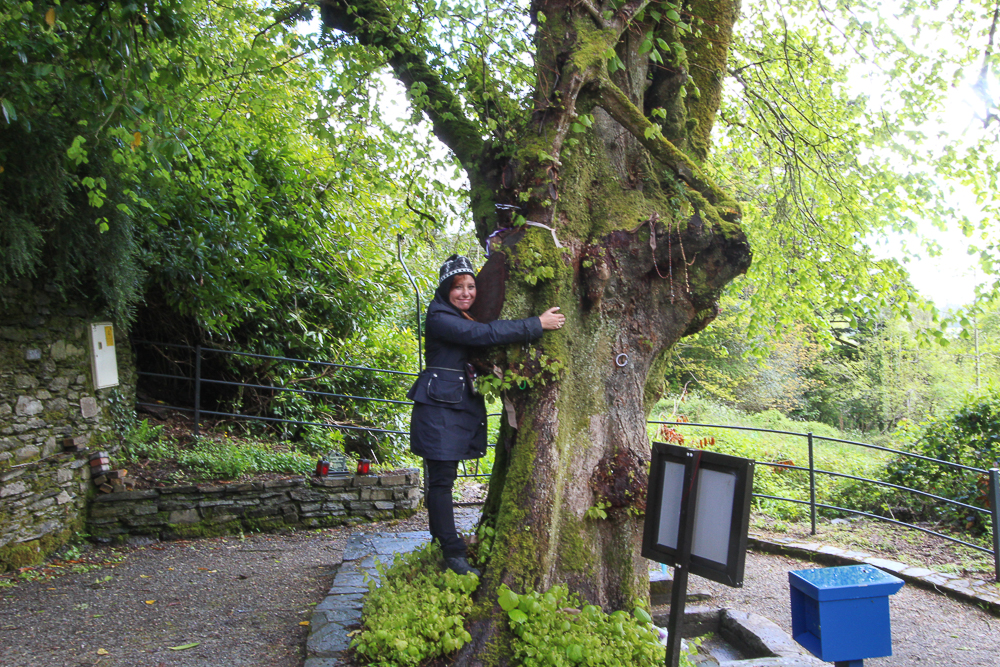
Tree at St. Gobnait’s Holy Well – Ballyvourney, Co. Cork
The connection between the eternal world and the physical is nearly unidentifiable in a place of resurrection – as they are knitted together in an inextricable pattern where neither can be separated from the other. The place of resurrection then is unto itself the combination of both worlds particularly suited to that specific spirit. … and Ballyvourney was St. Gobnait’s place.
What is yours?
St. Gobnait’s Holy Well – Ballyvourney
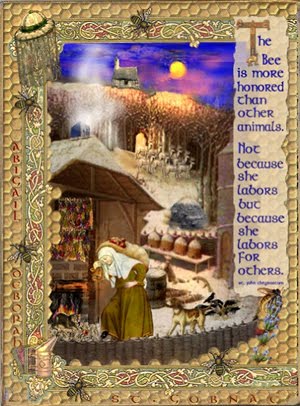
St. Gobnait – image by Patricia Banker
In the early 6th century when Gobnait fled her home in County Clare, she went to Inis Oírr. We don’t know why she fled, only that she believed she would find refuge in the Aran Islands.
Legend states that an angel appeared to her there and told her that her place was not on Inis Oírr, and instructed Gobnait to go on a journey – to seek her true place of resurrection. “Go until you find nine white deer grazing” the angel told her. “It is there that you will find your place of resurrection.”
So Gobnait wandered about the southern coastal counties of Ireland – Waterford, Cork and Kerry – searching.
She saw three white deer in Clondrohid and followed them to Ballymakeera where she saw six more. But it wasn’t until she came to Ballyvourney to a small rise overlooking the River Sullane that she saw the nine white deer all together – grazing … just as the angel from Inis Oírr had prophesied.
She crossed the river and settled there. She founded a religious community for women, performed memorable – some say miraculous works, and it was there she died and was buried.
Thin Places Mystical Tour
St. Gobnait’s shrine and holy well are stops on our Places of Resurrection tour .
DEVOTION TO ST. GOBNAIT
February 11th is St. Gobnait’s feast day -the day her memorable life is celebrated. She is one of the few Irish saints that is not only remembered in her native region, but has been proclaimed by the Irish bishops to be a national saint. There are shrines and places of devotion to St. Gobnait in all the places she is believed to have stopped on her journey – including Inis Oírr. But Ballyvourney, where she carried out most of her ministry, is the place that draws the greatest number of pilgrims devoted to this saint.

Today there is an active church on the former monastic site. St. Gobnait’s grave and marked spots around the churchyard are places where pilgrims pause for devotion and reflection. It is here that they can do the “rounds” or turas, always moving in a clockwise direction – a tradition that has pagan roots.
One of the strongest mystical draws on this site is St. Gobnait’s Holy Well, with its arched entryway that takes the pilgrim into a deeply shaded path. Just next to the well is a sturdy tree, and hanging from it are hundreds of tokens or clooties that have been placed there by pilgrims hoping to leave behind a part of themselves or loved on in need of healing. There are taps and cups available for drinking from the well or for pouring into personal vessels to take holy well water home.
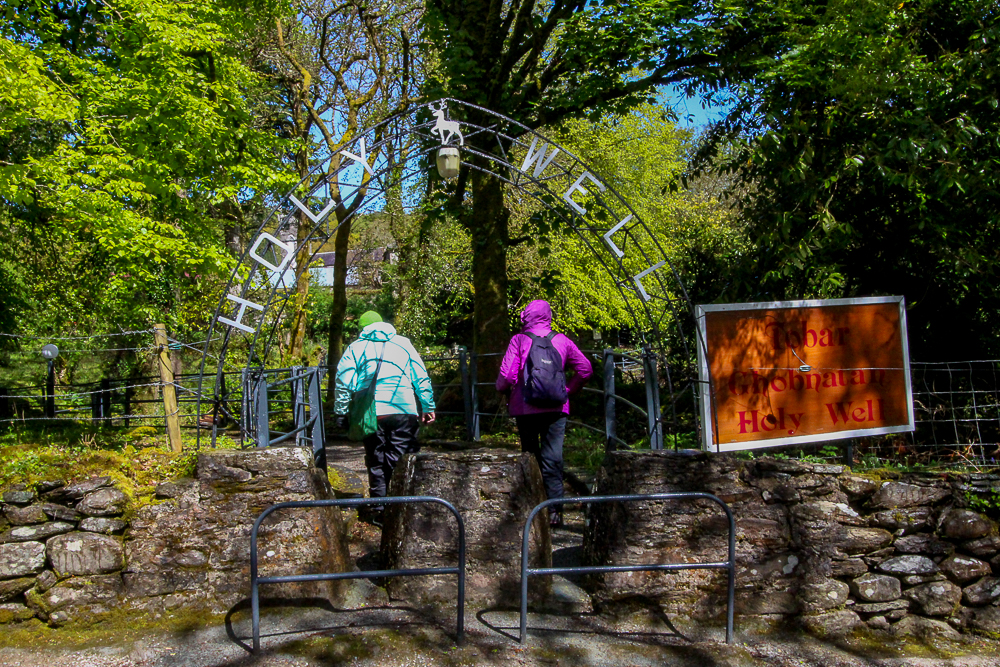
Entrance to St. Gobnait’s Holy Well
St. Gobnait was best known for her care of the sick. There is a legend that tells of her staving off the plague from Ballyvourney by drawing a line in sand with a stick and declaring the village “consecrated ground.” Inside the church today, there is a medieval (possibly 13th century) figure of St. Gobnait which is kept in a drawer. Every year on her feast day, the parish priest brings out the figure to celebrate a devotional tradition. He holds up the ancient figure and the faithful each step forward with a piece of ribbon. They hold the ribbon up and measure it against the length and around the circumference of the figure, then take it home as a blessed relic used for healing or further devotion.
A tall statue of St. Gobnait that was erected in the 1950s stands near the monastic site. She appears with a nun’s habit standing on a bee hive surrounded by bees. Gobnait is the patron saint of bee keepers, and there are several legends recalling Gobnait forcing invaders out of Ballyvourney by setting swarms of bees upon them. It’s probable that Gobnait had a close relationship with bees and used honey in healing efforts.
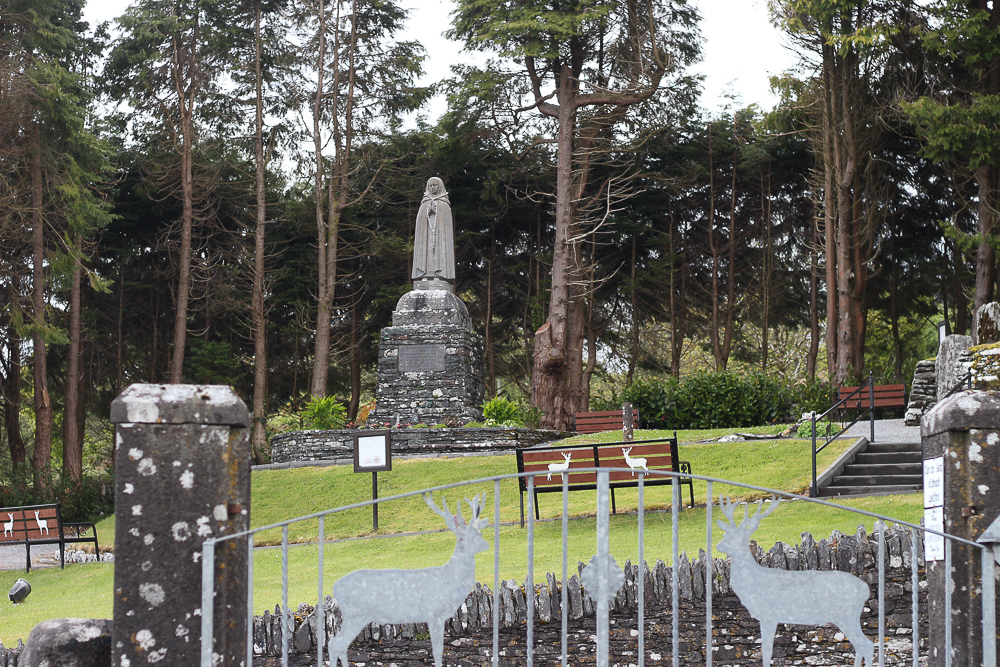
Statue of St. Gobnait at Ballyvourney
PLACE OF RESURRECTION
Dan and I visited St. Gobnait’s monastic site many years ago. It is indeed, a thin place. The stories of St. Gobnait specifically mention a “place of resurrection.” I heard Dara Molloy use this phrase when referring to his home on Inis Mór and have seen a few authors reference the phrase. But regarding thin places … a place of resurrection is the pinnacle – that place where one’s spirit is totally whole, at home, with no longing or yearning to be anywhere else. A place of resurrection is not only the place where one’s spirit will resurrect from its lifeless body upon death, but also the place where that spirit is most alive inside the living body. And I believe that a place of resurrection is the spiritual home where one is most completely alive and able to create, to discern, to prophesy … to be wise.

Tree at St. Gobnait’s Holy Well – Ballyvourney, Co. Cork
The connection between the eternal world and the physical is nearly unidentifiable in a place of resurrection – as they are knitted together in an inextricable pattern where neither can be separated from the other. The place of resurrection then is unto itself the combination of both worlds particularly suited to that specific spirit. … and Ballyvourney was St. Gobnait’s place.
What is yours?
Image of St. Gobnait courtesy of Patricia Banker; Copyright by Patricia Banker, All Rights Reserved. Used With Permission.
Kildare – St. Brigid’s Holy Well (Tobar Bride)
 Legend tells us that St Brigid was born near Kildare to a slave mother who was a Christian and very sickly. As a child, Brigid persuaded the Druid master to free her mother which in turn freed Brigid to enter religious life.
Legend tells us that St Brigid was born near Kildare to a slave mother who was a Christian and very sickly. As a child, Brigid persuaded the Druid master to free her mother which in turn freed Brigid to enter religious life.
Kildare is one of the stops on the Thin Places Mystical Tour of Ireland – Castles, Saints & Druids in September 2014.
Since there were no convents in Ireland, Brigid began one in Kildare. The sisters of St. Brigid prayed simply and deeply and served the poor. We know that Brigid was a contemporary of St. Patrick and a strong legend states that she was ordained a bishop because of her superior knowledge and closeness to God.
Another legend is associated with the goddess or holy woman, called Brigid dating back to pre-Christian times in this region. Stories of the two women have been woven and spun into legends and tales that all point to a holy woman, who drew followers to this site and performed rituals that were associated with healing, protection, comfort and help for the poor. The town of Kildare grew up around the community that this woman – Brigid – founded.
Kildare translated means “cell” or church of the oak. Oaks were known to be sacred trees in pre-Christian Ireland which gives weight to the pagan or goddess tradition of Brigid. But it is believed that a Christian woman named Brigid founded a community here around 480 AD, that she was a contemporary of St. Patrick and was recognized for great spiritual wisdom. There are legends that she was ordained a bishop in the church due to her wisdom.
Brigid is now one of Ireland’s patron saints, and is often linked in patronage to farmers and poor pastoral workers – the common citizen, the oppressed Irish tenant farmer of past centuries. It is possible – some say likely – that St. Brigid located her religious community on the spot where the Kildare Cathedral is now situated. 13th century buildings now occupy the spot along with the second tallest round tower in Ireland and an oratory and fire pit which likely date back to pagan times. Legend states that St. Brigid kept an flame burning in the fire pit continually as a devotion to the Holy Spirit. The perpetual flame is still cared for today by the Brigidine sisters who live nearby. For centuries this cathedral site has been a draw for pilgrims – a holy place, a place of spiritual strength.

Nearby is St. Brigid’s Holy Well, and the thinness of this place is palpable. This is actually a secondary well, springing from a known ancient holy well a short distance away. Volunteers and benefactors have created a beautiful setting around St. Brigid’s Holy Well also known as Tobar Bride. A bronze statue of St. Brigid lifting the eternal flame has been added in recent years. Stone prayer stations lead from the well to a running spring.
Wells were considered holy by the pre-Christian Irish being that they sprung from the “underworld” or the womb of the earth. That tradition of holiness exists today. Water from holy wells is believed to have special power for healing and spiritual protection.
“A holy well is very special. To watch water springing from the earth is to witness creation in the act of pure, unconditional generosity. At a holy well, my own interior holy well has an opportunity to make itself known to me.” – Gay Barbizon, Brigid’s Kildare; The Fire, the Well and the Oak.
Upon entering Tobar Bride, the pilgrim can see a small devotional shrine where donations are publicly accepted and welcomed. The old pagan tradition encourages the pilgrim to leave an offering when taking water from the well.
Pilgrims are encouraged to say prayers at each of the seven stations at Tobar Bride. Just past the small devotional shrine is the spring marked by a stone arch. This is the first station. Water flows through two oval shaped stones. Some say these stones symbolize the breasts of the earth – our mother. The bronze statue of St. Brigid is near to the arch.
Past the arch are five standing stones or “stations” that represent a part of Brigid’s nature. Pilgrims pause and recognize these qualities and perhaps pray for the same graces to develop in their own lives.
First stone – Brigid the woman of Ireland, the patroness, the protector of a beloved country.
Second stone – Brigid the peacemaker, healing division, bringing forward unity.
Third stone – Brigid the friend of the poor, advocate of the marginalized, speaker for they that have no voice.
Fourth stone – Brigid the hearthwoman, keeping the home flame burning, welcoming all, woman of hospitality.
Fifth stone – Brigid the woman of contemplation, which leads to wisdom and closeness with the Creator.

St. Brigid’s Holy Well – Kildare
The holy well behind the five standing stones marks the 7th station. It is here that one can pause and reflect, pray for a loved one, and draw water – perhaps to take to a loved one who is ill or to bless a home.
It is traditional belief that a person taking something from (holy water) from a devotional site should leave something behind. Notice the tree behind the well. Dangling from its branches are stips of cloth and other tokens – also known as “clooties” – that have been left behind by pilgrims. The cloth may have been touched to the person for whom the pilgrim is praying. Sometimes pilgrims leave photos or personal belongings behind – things that have touched the person they are praying for. This tree had a baby’s shoe dangling from a branch.
The pastoral setting of this park-like devotional space is near the Curragh – or places where the thoroughbred race horses – famous in Kildare – run and are kept. It is almost impossible not to be moved when entering this space.
This is a very Thin Place.

